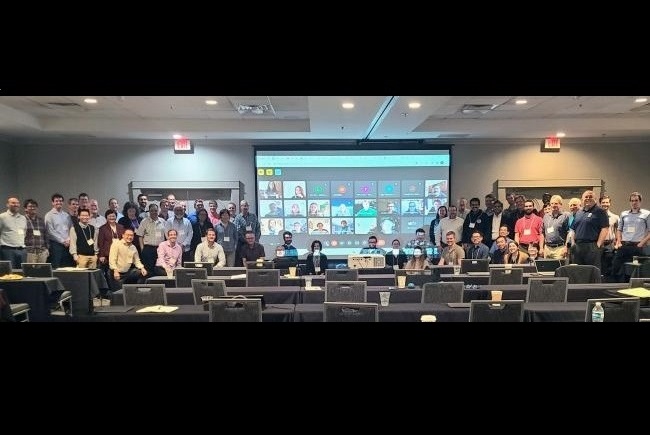HFIP Annual 2023 - OSTI Modeling
HFIP Annual Meeting 2023
Major Actions and Takeaways
- Actions
- Strategic Plan 2025: We need to create a new Strategic Plan for 2025, with updated 5-year and 10-year goals. Some things to think about when formulating these updated goals based upon discussions at HFIP Annual Meeting:
- Advance the operational hurricane analysis and forecast system (HAFS), including a HAFS-JEDI transition plan
- Improve probabilistic forecast guidance, by quantifying intensity, track, structure (RMW, R34) uncertainty (how do we measure R34 in model vs obs?), and greater emphasis on leveraging tools such as reanalysis and machine learning
- Enhance communication of risk and uncertainty. Application of triangulation results to product suite (AFS Tropical Roadmap)
- Support Dedicated High Performance Computing Allocation - Dedicated RDHPC vs Cloud
- R2O Enhancements (HOT, DTC, EPIC, UFS R2O)
- Broaden expertise and expand interaction with external community via EPIC and UFS
- Tiger Teams: We will form two tiger teams, one for data assimilation (DA) and the other for uncertainty quantification (UQ)
- The DA team will be led by Jason Sippel and Daryl Kleist, and will focus on the need to replace GSI with JEDI. Which model infrastructure, physics, etc updates will need to be delayed in order to test, evaluate, and implement JEDI? If other model development continues at same speed, it will continue to delay JEDI implementation. DA tiger team will develop an implementation plan and oversee progress and eventual transition. They will target the HAFSv3 FY25 transition, coincident with GFSv18.
- The UQ tiger team will be led by Wallace Hogsett and one other person (from CIRA? TBD). This team will provide a proof of concept: Provide storm specific ensemble model statistics to produce PDFs of model parameters (track, wind, RMW, R34, etc.) to develop, test & evaluate uncertainty information guidance for WTCM, WSP, P-surge, & P-Rain operational forecast guidance products (HAFS ensemble, CTCX ensemble, GEFS, etc.) using ML approaches e.g., DESI, TCANE. First develop a proof of concept, develop new probabilistic tools and products, and then calibrate and verify these products. Explore cost versus benefit of single-model versus multi-model ensemble. Leverage ML approaches, such as DESI and TCANE.
- HAFS Training Tutorial: HFIP will work with the community, EPIC, and DTC to coordinate a HAFS tutorial to increase the user base, as was done with HWRF in the past.
- Strategic Plan 2025: We need to create a new Strategic Plan for 2025, with updated 5-year and 10-year goals. Some things to think about when formulating these updated goals based upon discussions at HFIP Annual Meeting:
- Takeaways
- Need to establish new 2025 strategic plan with updated 5 and 10 year goals. First strategic plan was in 2009, last updated in 2019. Need clear goals, as was done in the past.
- Transition from GSI to JEDI will be a major step that we need to take.
- Improved probabilistic guidance, quantification of uncertainty. Can we better leverage reanalysis, or machine learning for this?
- Enhance communication, particularly with respect to risk uncertainty
- Need dedicated HPC support, and strategy for continued adoption of cloud.
- R2O enhancements and collaboration with HOT, DTC, EPIC, and UFS R2O. Broaden expertise and expand community, particularly through EPIC and UFS.
- Need to increase diversity in the models, particularly between HAFS-A and -B. Physics diversity helps, but also need diversity in the initial conditions.
- Need more focus on storm structure, particularly in terms of size of the wind field. Not only does a larger wind field impact a larger region, but it also is the main driver of storm surge.
- Why are there differences in model forecasts in large bust cases? For example, why was HAFS-B consistently better than HAFS-A for Philippe (2023)?
- What can the global system do to make our lives easier on the TC side? At which point is the GFS cycling good enough that HAFS does not have to run its own cycling? 6-km resolution DA using JEDI is consistent with GFSv18 development ~5 years out.
- NHC would like to see us optimize and verify the wind speed probability thresholds. Need to make sure we get data into AWIPS.
- Need to think about physics issues, particularly in the “gray zone” for parameterized deep convection.
- NHC: top priority should be to make sure spread-error score is appropriately tuned for track and intensity at all lead times.
- Need to develop improved precipitation forecasts for TCs. Inland freshwater flooding is a major source of damage and loss of life.
- Need to verify probabilistic wind swath and probabilistic precipitation forecasts. Does a 40% chance of wind above X threshold or precipitation above Y threshold verify 40% of the time?

Day 1- Recordings
Session 1A: Leadership Remarks and Updates - https://youtu.be/DNAPFO6UY38
Session 1B: Forecaster Needs and Activities Supporting Operations - https://youtu.be/Dc7igPeFqKE
Session 2A: Challenging storm working group - https://youtu.be/WLuJjAj677Q
Session 2B: Impact of Recon Data on TC Forecasts - https://youtu.be/ulhNdIL0nVo
Day 2- Recordings
Session 3A: HAFS Implementation 23/24 - https://youtu.be/TGDoM45f5k8
Session 3B: HFIP R2O & O2R - https://youtu.be/BQ1GwI6v8z4
Session 4A: Hurricane Observations Panel - https://youtu.be/7HA-A1-_LTU
Session 4B: DA and Impacts - https://youtu.be/Fz9hYFsTQcI
Session 4C: Focused DA Discussion & Lessons Learned - https://youtu.be/Jmlg9NHhuPQ
Day 3 - Recordings
Session 5A: 5A Social and Economic Impacts - https://youtu.be/p3ilXZ7Gnxk
Session 5B: Coastal impacts & Vulnerability Brainstorming - https://youtu.be/rpND_yVdHp4
Session 6A1: Supplementals and JTTI - https://youtu.be/79n0RsntMQA
Session 6B: WPO Testbeds: H.O.T. - https://youtu.be/BeM3rDHZuic
Day 4- Recordings
Session 7A: Developer Support and HPC - https://youtu.be/j7jWThFXa1w
Session 7B.1: HPC Future and Strategic Planning - https://youtu.be/xTDI1t06aaY
Session 7B.2: Strategic Goal Planning - https://youtu.be/HYI5Kme45z
